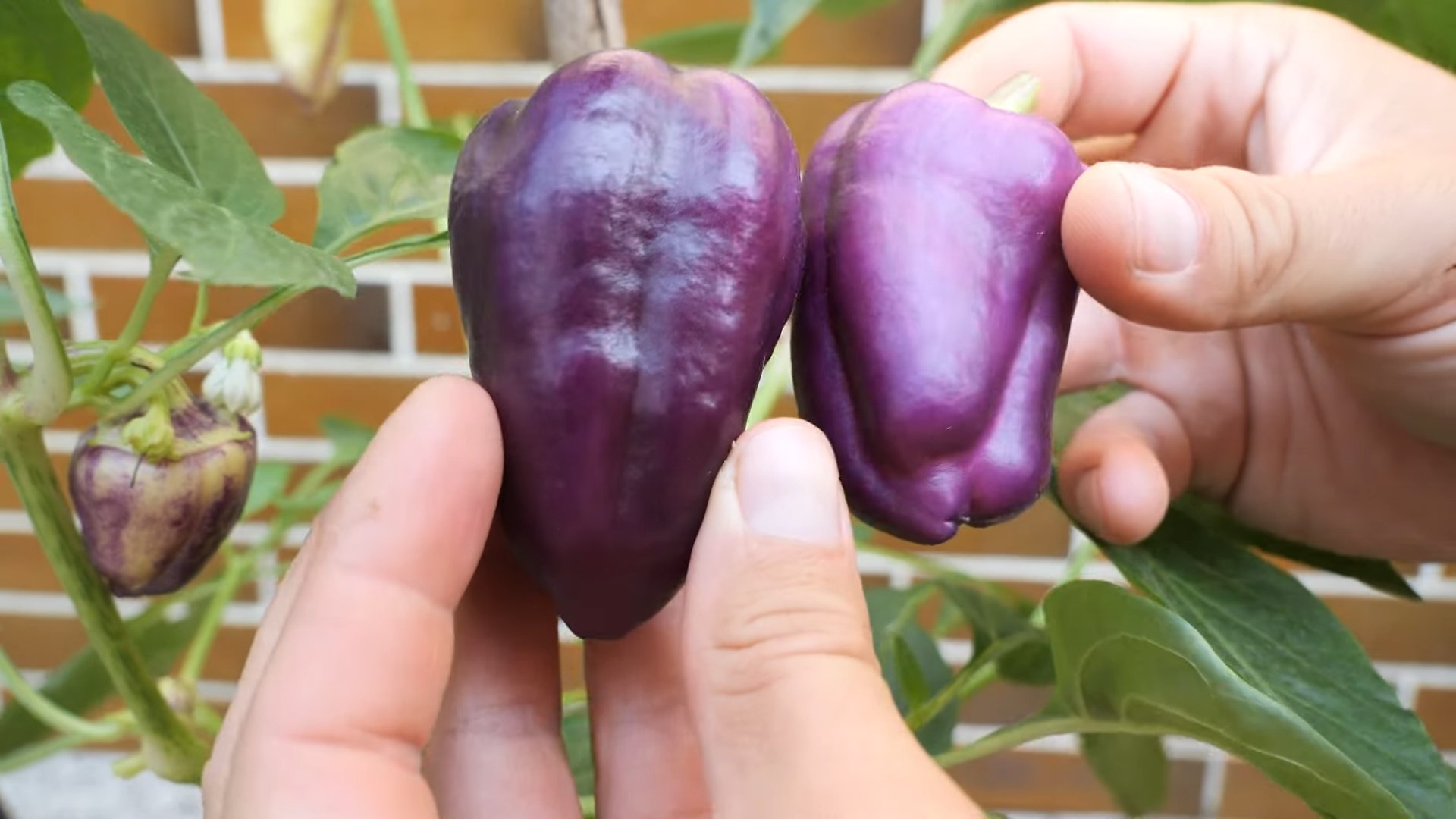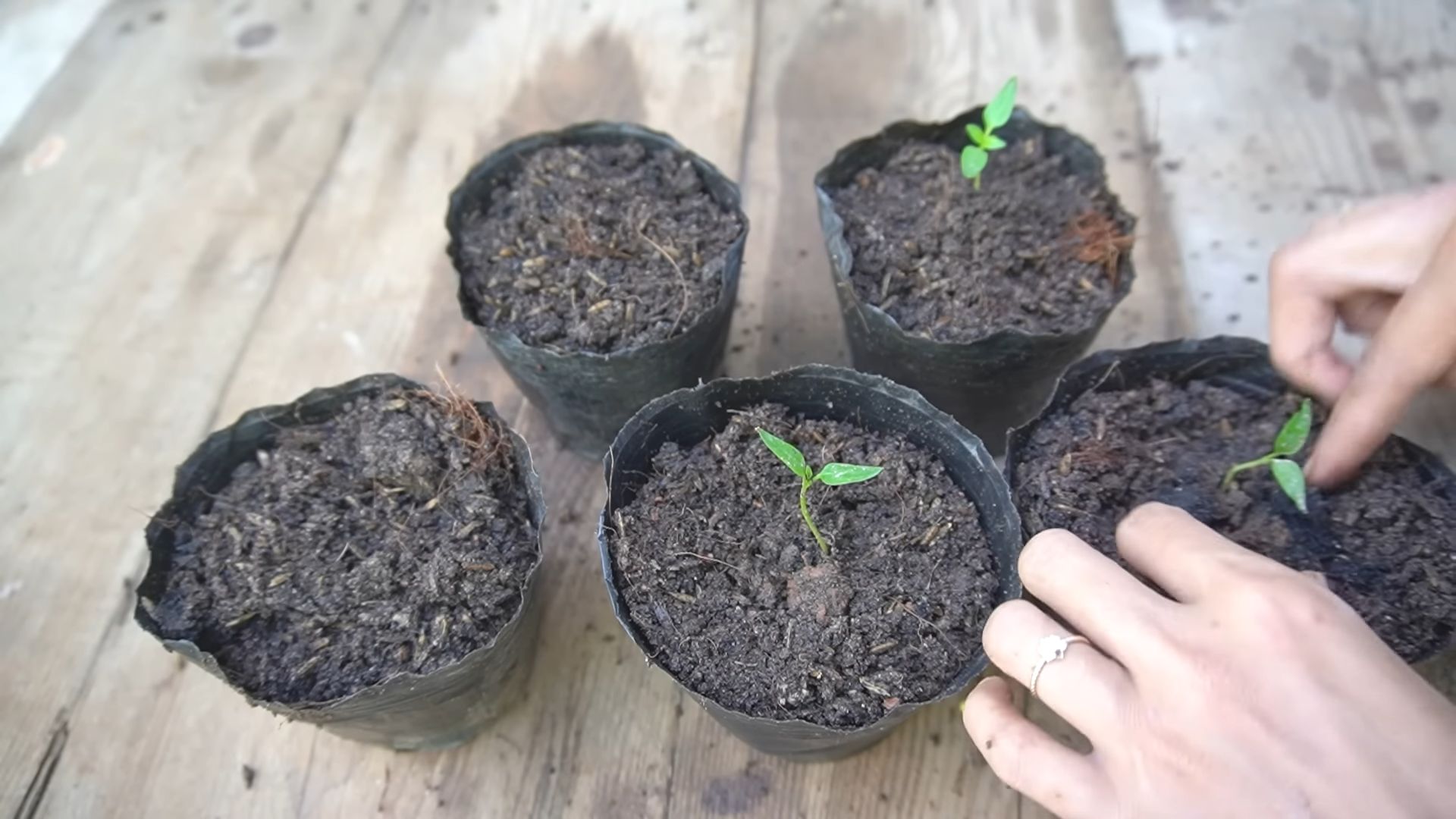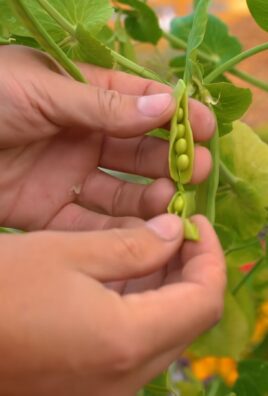Purple Sweet Peppers Growing can seem like a daunting task, especially if you’re new to home gardening. But trust me, with a few simple tricks and a little DIY magic, you can be harvesting these vibrant beauties in no time! Forget those bland, store-bought peppers – imagine the satisfaction of plucking a perfectly ripe, deep purple pepper straight from your own garden.
For centuries, peppers have been cultivated around the world, adding spice and flavor to countless cuisines. While the common green bell pepper is a supermarket staple, exploring the world of purple sweet peppers opens up a whole new realm of culinary possibilities. These peppers aren’t just visually stunning; they also boast a unique, slightly sweeter flavor profile that elevates any dish.
Why should you embark on this DIY adventure? Well, for starters, growing your own food is incredibly rewarding. Plus, you have complete control over what goes into your plants, ensuring you’re enjoying fresh, healthy produce free from harmful chemicals. And let’s be honest, who wouldn’t want to impress their friends and family with a garden bursting with vibrant purple sweet peppers growing proudly? This article is packed with easy-to-follow tips and tricks that will guide you through every step of the process, from selecting the right seeds to harvesting your bountiful crop. So, grab your gardening gloves, and let’s get started!

Growing Gorgeous Purple Sweet Peppers: A DIY Guide
Alright, pepper enthusiasts! So, you want to grow those stunning, vibrant purple sweet peppers, huh? I don’t blame you! They’re not only beautiful additions to your garden, but they also pack a delicious, sweet punch. I’ve been growing them for years, and I’m excited to share my secrets to success. Let’s dive in!
Choosing the Right Variety
First things first, you need to pick the right variety. Not all purple peppers are created equal! Some are hotter than others, and some are more prone to certain diseases. Here are a few of my favorites:
* ‘Purple Beauty’: This is a classic choice. It’s reliable, produces good yields, and the peppers are a lovely deep purple. They’re also relatively early to mature, which is a bonus if you live in a cooler climate.
* ‘Sweet Purple’: As the name suggests, these are incredibly sweet and mild. They’re perfect for snacking or adding to salads.
* ‘Oda’: This variety is a bit more unique. The peppers start out green and then mature to a beautiful, glossy purple. They have a slightly more complex flavor than some of the other sweet purple varieties.
* ‘Violetta’: This Italian heirloom is known for its large, blocky peppers and rich, sweet flavor. It’s a bit later to mature than some of the other varieties, but it’s well worth the wait.
Starting Your Seeds (or Buying Seedlings)
You have two options here: start your seeds indoors or buy seedlings from a nursery. I personally prefer starting my seeds indoors because it gives me more control over the process and allows me to get a head start on the growing season.
Starting Seeds Indoors:
* Timing is Key: Start your seeds about 6-8 weeks before the last expected frost in your area. This will give them plenty of time to germinate and grow into strong seedlings.
* Gather Your Supplies: You’ll need seed starting trays or small pots, seed starting mix (not regular potting soil!), a heat mat (optional, but highly recommended), a grow light (also optional, but it makes a huge difference), and of course, your purple sweet pepper seeds.
* Sowing the Seeds: Moisten the seed starting mix and fill your trays or pots. Sow the seeds about ¼ inch deep and gently cover them with soil.
* Providing Warmth and Light: Place the trays or pots on a heat mat and under a grow light. The ideal temperature for germination is around 75-85°F. Keep the soil consistently moist, but not soggy.
* Patience is a Virtue: It can take anywhere from 7-14 days for the seeds to germinate. Once they sprout, remove the heat mat and keep the grow light on for about 14-16 hours per day.
* Thinning the Seedlings: Once the seedlings have their first true leaves (the second set of leaves that appear after the initial seed leaves), thin them out so that only one seedling remains in each cell or pot. Choose the strongest, healthiest-looking seedling.
* Hardening Off: Before transplanting the seedlings outdoors, you need to “harden them off.” This means gradually exposing them to outdoor conditions over a period of about a week. Start by placing them in a sheltered spot outdoors for a few hours each day, gradually increasing the amount of time they spend outside.
Buying Seedlings:
* Choose Wisely: When buying seedlings, look for plants that are healthy, sturdy, and have a good green color. Avoid plants that are leggy, yellowing, or have any signs of pests or diseases.
* Check the Roots: Gently remove the seedling from its pot and inspect the roots. They should be white or light brown and not root-bound (meaning they’re tightly circling the pot).
* Harden Off (Even Store-Bought Seedlings): Even if you buy seedlings from a nursery, it’s still a good idea to harden them off for a few days before transplanting them into your garden.
Preparing Your Garden Bed
Purple sweet peppers need plenty of sunshine and well-drained soil. Choose a location that gets at least 6-8 hours of direct sunlight per day.
* Soil Preparation: Amend your soil with plenty of compost or other organic matter. This will improve drainage, fertility, and water retention. Peppers prefer slightly acidic soil with a pH of around 6.0-6.8. You can test your soil pH with a soil testing kit.
* Spacing: Space your pepper plants about 18-24 inches apart in rows that are 24-36 inches apart. This will give them plenty of room to grow and allow for good air circulation.
* Support: Consider providing support for your pepper plants, especially if you’re growing a variety that produces large, heavy peppers. You can use stakes, cages, or trellises.
Transplanting Your Seedlings
Once the danger of frost has passed and the soil has warmed up, it’s time to transplant your seedlings into the garden.
1. Water Thoroughly: Water your seedlings well before transplanting them. This will help them to establish their roots more quickly.
2. Dig the Holes: Dig holes that are slightly larger than the root balls of your seedlings.
3. Gently Remove the Seedlings: Gently remove the seedlings from their pots, being careful not to damage the roots.
4. Place the Seedlings in the Holes: Place the seedlings in the holes and backfill with soil. Gently firm the soil around the base of the plants.
5. Water Again: Water the newly transplanted seedlings thoroughly.
6. Mulch: Apply a layer of mulch around the base of the plants. This will help to retain moisture, suppress weeds, and regulate soil temperature. I like to use straw or shredded leaves.
Caring for Your Purple Sweet Peppers
Now that your pepper plants are in the ground, it’s time to provide them with the care they need to thrive.
* Watering: Water your pepper plants regularly, especially during hot, dry weather. Aim to keep the soil consistently moist, but not soggy. Water deeply and less frequently, rather than shallowly and more often.
* Fertilizing: Fertilize your pepper plants every 2-3 weeks with a balanced fertilizer. Look for a fertilizer that is specifically formulated for vegetables. I like to use a liquid fertilizer that I can apply with a watering can.
* Pest Control: Keep an eye out for pests such as aphids, flea beetles, and pepper weevils. If you spot any pests, take action immediately. You can use insecticidal soap, neem oil, or other organic pest control methods.
* Weed Control: Keep your garden bed free of weeds. Weeds compete with your pepper plants for water, nutrients, and sunlight.
* Pruning: Pruning isn’t strictly necessary, but it can help to improve air circulation and encourage bushier growth. You can prune away any suckers (small shoots that grow from the base of the plant) or any yellowing or diseased leaves.
Harvesting Your Purple Sweet Peppers
The moment you’ve been waiting for! Harvesting those beautiful purple peppers.
* Timing is Everything: Purple sweet peppers are typically ready to harvest about 60-80 days after transplanting. The peppers should be firm, glossy, and a deep purple color.
* Gentle Harvesting: Use a sharp knife or pruning shears to cut the peppers from the plant. Be careful not to damage the plant.
* Enjoy the Bounty: Purple sweet peppers are delicious eaten raw, grilled, roasted, or added to salads, stir-fries, and other dishes.
Troubleshooting Common Problems
Even with the best care, you may encounter some problems when growing purple sweet peppers. Here are a few common issues and how to address them:
* Blossom End Rot: This is a common problem that causes the bottom of the pepper to rot. It’s usually caused by a calcium deficiency or inconsistent watering. To prevent blossom end rot, make sure your soil is rich in calcium and water your plants regularly. You can also add calcium to the soil by adding crushed eggshells or bone meal.
* Sunscald: This occurs when the peppers are exposed to too much direct sunlight, causing them to develop white or yellow patches. To prevent sunscald, provide some shade for your pepper plants during the hottest part of the day. You can use shade cloth or plant them near taller plants.
* Pest Infestations: As mentioned earlier, peppers can be susceptible to various pests. Regularly inspect your plants for pests and take action immediately if you spot any.
* Disease: Peppers can also be affected by various diseases, such as fungal diseases and bacterial diseases. To prevent disease, choose disease-resistant varieties, provide good air circulation, and avoid overwatering.
Extra Tips for Success
*

Conclusion
So, there you have it! Growing your own purple sweet peppers is not only achievable, but it’s also incredibly rewarding. Imagine the vibrant color and unique sweetness you’ll bring to your dishes, all thanks to your own green thumb. This isn’t just about adding another vegetable to your garden; it’s about cultivating a conversation starter, a culinary delight, and a source of immense personal satisfaction.
Why is this DIY trick a must-try? Because it empowers you to control the entire process, from seed to table. You know exactly what goes into your peppers – no mystery chemicals or long-distance transportation. Plus, the taste of a homegrown purple sweet pepper, ripened to perfection under your loving care, is simply unparalleled. It’s a flavor explosion that store-bought peppers just can’t replicate.
Beyond the basic method, there’s plenty of room for experimentation. Try different soil mixes to see which yields the best results in your specific climate. Consider companion planting with herbs like basil or rosemary, which are known to deter pests and enhance the flavor of your peppers. You could even explore growing different varieties of purple sweet peppers, each with its own subtle nuances in taste and appearance. Some varieties are more compact, ideal for container gardening, while others are larger and more productive, perfect for sprawling garden beds.
Don’t be afraid to get creative with your harvest! Purple sweet peppers are incredibly versatile. Roast them for a smoky sweetness, stuff them with rice and vegetables for a hearty meal, or pickle them for a tangy treat. They add a beautiful pop of color to salads, stir-fries, and even homemade salsas. The possibilities are endless!
We wholeheartedly encourage you to embark on this gardening adventure. Growing your own purple sweet peppers is a journey of discovery, a chance to connect with nature, and a way to bring fresh, healthy food to your table. It’s a project that’s both challenging and deeply fulfilling.
And most importantly, we want to hear about your experience! Share your tips, your triumphs, and even your occasional setbacks in the comments below. Let’s build a community of purple sweet pepper enthusiasts, sharing our knowledge and inspiring each other to grow the best peppers possible. Your insights could be invaluable to other aspiring gardeners. So, grab your seeds, get your hands dirty, and let’s grow some amazing purple sweet peppers together! We are confident that you will find this **purple sweet peppers** growing experience to be a delightful and rewarding one.
Frequently Asked Questions (FAQ)
1. What are the best conditions for growing purple sweet peppers?
Purple sweet peppers thrive in warm weather and require plenty of sunlight. Aim for at least 6-8 hours of direct sunlight per day. The ideal temperature range is between 70-85°F (21-29°C). They also need well-drained soil that is rich in organic matter. Amend your soil with compost or aged manure before planting to provide essential nutrients. Consistent watering is crucial, especially during hot weather. Avoid overwatering, which can lead to root rot.
2. How long does it take for purple sweet peppers to mature?
The time it takes for purple sweet peppers to mature depends on the variety and growing conditions. Generally, you can expect to harvest your peppers about 60-80 days after transplanting seedlings. Keep an eye on the color of the peppers; they are typically ready to harvest when they have reached their full purple color and are firm to the touch.
3. What are some common pests and diseases that affect purple sweet peppers?
Common pests that can affect purple sweet peppers include aphids, spider mites, and pepper weevils. Regularly inspect your plants for signs of infestation and take appropriate action, such as using insecticidal soap or neem oil. Diseases like blossom-end rot and fungal infections can also be a problem. Ensure proper watering and drainage to prevent these issues. Consider using a fungicide if necessary. Crop rotation can also help prevent soil-borne diseases.
4. Can I grow purple sweet peppers in containers?
Yes, purple sweet peppers can be successfully grown in containers. Choose a container that is at least 12 inches in diameter and has good drainage holes. Use a high-quality potting mix and provide regular watering and fertilization. Container-grown peppers may require more frequent watering than those grown in the ground, especially during hot weather. Make sure the container is placed in a sunny location.
5. How often should I fertilize my purple sweet pepper plants?
Fertilize your purple sweet pepper plants every 2-3 weeks with a balanced fertilizer. Look for a fertilizer that is specifically formulated for vegetables or tomatoes. Avoid over-fertilizing, which can lead to excessive foliage growth and fewer peppers. You can also use organic fertilizers like compost tea or fish emulsion.
6. What is blossom-end rot, and how can I prevent it?
Blossom-end rot is a common problem in peppers and tomatoes, characterized by a dark, sunken spot on the bottom of the fruit. It is caused by a calcium deficiency, often due to inconsistent watering. To prevent blossom-end rot, ensure consistent watering and avoid letting the soil dry out completely. You can also add calcium to the soil by incorporating bone meal or crushed eggshells.
7. How do I know when to harvest my purple sweet peppers?
Purple sweet peppers are typically ready to harvest when they have reached their full purple color and are firm to the touch. You can also harvest them when they are still green, but they will not be as sweet. Use a sharp knife or pruning shears to cut the peppers from the plant, leaving a small stem attached.
8. Can I save seeds from my purple sweet peppers to plant next year?
Yes, you can save seeds from your purple sweet peppers, but keep in mind that they may not be true to type if the plants were cross-pollinated with other pepper varieties. To save seeds, allow the peppers to fully ripen on the plant until they are soft and slightly wrinkled. Remove the seeds and dry them thoroughly before storing them in a cool, dry place.
9. What are some good companion plants for purple sweet peppers?
Good companion plants for purple sweet peppers include basil, rosemary, marigolds, and carrots. Basil and rosemary are known to deter pests, while marigolds attract beneficial insects. Carrots help to loosen the soil and improve drainage. Avoid planting peppers near fennel, which can inhibit their growth.
10. My purple sweet pepper plants are producing flowers, but no peppers. What could be the problem?
There are several reasons why your purple sweet pepper plants may be producing flowers but no peppers. One common cause is lack of pollination. Peppers are self-pollinating, but they may need help from wind or insects to transfer pollen. You can try gently shaking the plants to encourage pollination. Other possible causes include extreme temperatures, lack of water, or nutrient deficiencies. Ensure that your plants are receiving adequate sunlight, water, and fertilizer.




Leave a Comment